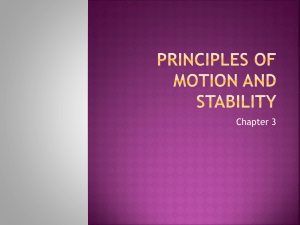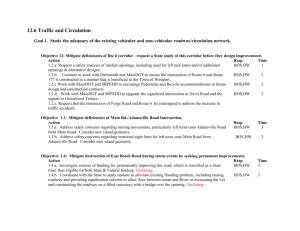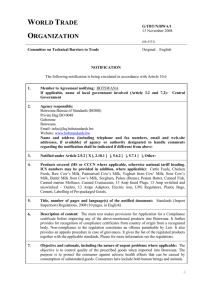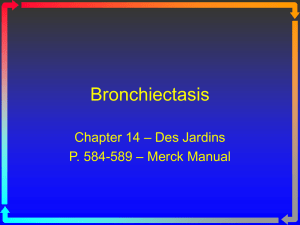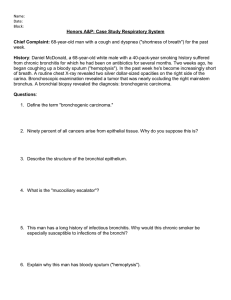Bronchial Obstruction in Children
advertisement
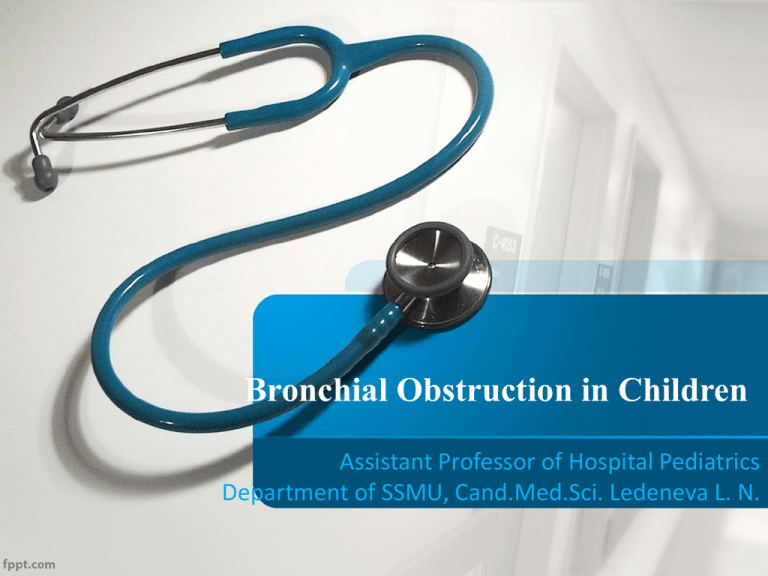
Bronchial Obstruction in Children Assistant Professor of Hospital Pediatrics Department of SSMU, Cand.Med.Sci. Ledeneva L. N. * Bronchoobstructive syndrome (BOS) occurs in children quite often, sometimes it takes a very severe course. * The syndrome of bronchial obstruction in children manifests, as a rule, against a background of respiratory infection and in the first place, it is a manifestation of acute obstructive bronchitis and asthma, but it can be a manifestation of other pathological conditions. * In most cases, BOS prognosis is serious and depends on the cause of bronchial obstruction, on the forms of the disease, timely conducted pathogenetic therapy and prevention. The urgency of the problem of BOS • In childhood, respiratory diseases occupy one of the first places. • Hereditary factors, environmental pollution, social factors play an important role in it. • In recent years there has been a marked increase in diseases that occur with an obstructive syndrome, which is very diverse in nature and may be a manifestation of many diseases. • Manifestation of the syndrome usually occurs on the background of acute respiratory viral infection, it takes a severe course and is accompanied by signs of respiratory failure. • Early diagnosis of the diseases that caused the obstruction, timely pathogenetic treatment and prevention reduces or eliminates clinical manifestations of the syndrome, and thus improves the quality of life of patients. The objective of the lecture • Coverage of modern concepts, the course and treatment of bronchial obstruction in children. The significance of the problem of BОS • Inadequate diagnosis • The lack of a comprehensive program of monitoring of the patients • The lack of continuity of treatment in the hospital and continuing of treatment on an outpatient basis • The need for rehabilitation and social adaptation Connection with previous lectures • Symptom complex of BOS: obstructive bronchitis, bronchitis caused by atypical flora (chlamydia, mycoplasma), asthma, cystic fibrosis and other pathological conditions have close clinical, diagnostic and therapeutic parallels between them. Sections of the lecture 1. 2. 3. 4. 5. Causes and risk factors for bronchial obstruction syndrome. Mechanisms of formation of bronchial obstruction in children. Clinical manifestations of the most common diseases in children, that take their course with obstructive syndrome and their differential characteristics. Standard programs for the child’s screening to clarify the etiology of the disease. Principles of treatment of bronchial obstruction syndrome in infants. DEFINITION • Bronchoobstructive syndrome (BOS) is a symptom complex associated with impaired bronchial patency of functional or organic origin. • In Western literature this clinical symptom complex is currently called wheezing - wheezing syndrome. • The term "BOS" can not be used as an independent diagnosis. BOS is a symptom complex of any disease, the etiology of which is necessary to determine in all cases of the development of bronchial obstruction. • The prevalence of obstructive conditions of the airways is quite high, especially in children during the first 6 years of life which is associated with anatomico-physiological features of the respiratory tract in infants. • Prevalence of BOS on the background of respiratory infections in infants ranges from 5% to 50%. • Most often obstructive conditions occur in children with a family history of allergies, as well as in children, who often suffer from respiratory infections (more than 6 times). BOS Clinical Picture • prolonged exhale • wheezing, noisy breathing (expiratory dyspnea, BH 50 and more per minute) • asthmatic fits • auxiliary muscles participating in breathing • poorly productive cough • decrease in oxygen partial pressure. BOS Predispose Factors Anatomical and physiological factors in young children: • the relative narrowness of the respiratory tract • hyperplasia of glandular tissue • rich vascularization of the mucous • predominantly viscous mucus secretion • low collateral ventilation • insufficient local immunity • relative weakness of the diaphragm Factors of premorbid background: • coupled allergic history • a genetic predisposition to atopy • perinatal pathology • bronchial hyperreactivity • rickets • malnutrition • early formula feeding • respiratory diseases Environmental Factors: • unfavorable environmental conditions • passive smoking • smoke inhalation promotes disruption of mucociliary clearance, causes hypertrophy of bronchial mucous glands, destruction of bronchial epithelium, reduces phagocytic activity of macrophages, reduces the activity of T- lymphocytes, stimulates IgE synthesis, increases the activity of the vagus nerve • in children with alcohol fetopathy atopy develops, mucociliary clearance is broken, protective immunological reactions are slowed. Etiology of BOS • Acute stenosing laryngotracheobronchitis of viral, bacterial and viral etiology of diphtheria. • Peritonsillar abscess, retropharyngeal abscess, epiglotit, congenital stridor, hypertrophy of the tonsils and adenoids, cysts, hemangioma and papillomatosis of the larynx. • In infants - aspiration caused by swallowing disorders, congenital abnormalities of the nasopharynx, chalasia and achalasia of the esophagus, tracheobronchial fistulas, gastroesophageal reflux disease. • Malformations of trachea, bronchi, RDS, cystic fibrosis, bronchopulmonary dysplasia, immunodeficiency, intrauterine infection. • At the 2nd and 3rd year of life BOS occurs in children with asthma, with foreign body aspiration, during migration of round helminths, in bronchiolitis obliterans, in patients with congenital and hereditary diseases of the respiratory system, in children with CHD, proceeding with pulmonary hypertension. • However, the main causes of bronchial obstruction in children are acute obstructive bronchitis and bronchial asthma! The pathogenesis of bronchial obstruction depends on the etiology of the disease. Pathogenetic mechanisms can be divided into two groups: 1. Functional (reversible). It is bronchospasm, inflammatory infiltration, edema, violation of mucociliary clearance, hypersecretion. 2. Irreversible (congenital stenosis of the bronchi and others). • The main factor of the pathogenesis of 1 group BOS is inflammation, which can be both infectious and allergic in children . • The mediator of the acute phase of inflammation is interleukin-1 (IL-1). • It is produced by phagocytic cells and tissue macrophages under the action of infection, allergy and promotes the release of first type mediators (histamine, serotonin) into peripheral blood. • These mediators are constantly present in the granules of mast cells and basophils, that ensures very rapid biological effects. • Besides histamine, an important role in the pathogenesis of inflammation is played by mediators of a second type (eicosanoids) generated during the early inflammatory response. • The source of eicosanoids is arachidonic acid, formed of phospholipids of cell membranes. • Under the action of cyclooxygenase from arachidonic acid prostaglandins, thromboxane and prostacyclin are synthesized, and under the action of lipoxygenase - leukotrienes. It is due to histamine, leukotrienes and antiinflammatory prostaglandins that we observe: • enhancement of vascular permeability • edema of bronchial mucosa • hypersecretion of mucus viscous • bronchoconstriction • Damaged tissues have an increased sensitivity of receptors of the bronchi to external influences (viral infection, pollutants), which significantly increases the risk of bronchospasm. • In damaged tissues anti-inflammatory cytokines are synthesized, degranulation of neutrophils, basophils, eosinophils occurs, thereby increasing the concentration of such biologically active substances as bradykinin, histamine, oxygen free radicals, which are also involved in the development of inflammation. • Thus, the disease process assumes the character of "vicious circle", predisposes to a long course of airway obstruction and superinfection! • BOS is accompanied by an increase in the amount of secretion in the bronchi and by increase of its viscosity. • Activity of mucous and serous glands is regulated by the parasympathetic nervous system, and acetylcholine stimulates their activity. • Such a reaction is initially of defensive nature. • However, the stagnation of bronchial content leads to disruption of ventilation and respiratory function of the lungs, and the inevitable infection - to the development of endobronchial or bronchopulmonary inflammation. • Furthermore, thick secretion may cause obstruction of the respiratory tract due to the accumulation of mucus in the upper or lower airways. • In severe cases, atelectasis may develop. • Edema and hypersecretion of the mucous membrane of the respiratory tract is also one of the causes of bronchial obstruction. • There is a thickening of all layers of the bronchial wall, which leads to bronchial obstruction. • At recurrent bronchopulmonary diseases the structure of the epithelium is disrupted, its hyperplasia and squamous metaplasia are marked. • Certainly, bronchospasm, is a major cause of BOS in older children. • Thus, there are several basic mechanisms of bronchial obstruction. • The share of each of them depends on the reasons for the disease process and the child's age. Grouping of bronchial obstruction About 100 diseases associated with BOS are known . There is no common classification. Considering the data from the literature, the following groups of the diseases involving BOS can be defined. 1. Diseases of the respiratory system. • infectious inflammation (bronchitis, bronchiolitis). • bronchial asthma • aspiration of foreign bodies • bronchopulmonary dysplasia • malformations of the respiratory system • obliterating bronchiolitis • tuberculosis 2. Diseases of the digestive tract •esophageal chalasia and achalasia •gastroesophageal reflux disease •tracheoesophageal fistula •diaphragmatic hernia 3. Hereditary diseases •cystic fibrosis, •deficiency of alpha-1-antitrypsin •mucopolysaccharidoses •rickets-like diseases 4. Parasitic infections (toxocariasis) 5. Diseases of the CAS 6. Diseases of the central and peripheral nervous system (birth trauma, myopathy, etc.). 7. Congenital and acquired immunodeficiency 8. The impact of various physical and chemical environmental factors 9. Other reasons (endocrine diseases, systemic vasculitis, Thymomegalia et al.) From a practical point of view, 4 basic groups of BOS causes are distinguished: • • • • infectious allergic obstructive hemodynamic • • • • By duration, BOS can be: acute (BOS clinical manifestations persist for more than 10 days) protracted recurrent continuously recurring According to the severity, the obstruction can be identified as: • mild • moderate • severe • latent bronchial obstruction Criteria for severity of BOS • • • • • • wheezing dyspnea of expiratory character cyanosis auxiliary muscles participating in breathing lung function (LF) and blood gases indices cough is seen with any degree of BOS Mild BOS • wheezing on auscultation • no breathlessness and cyanosis at rest • indices of blood gases are within the normal range • ERF indices (FEV1, PSV) are moderately reduced • state of health of the child, as a rule, does not suffer BOS of moderate severity • • • • • expiratory or mixed dyspnea at rest cyanosis of nasolabial triangle indrawing of compliant places of the chest wheezing is audible at a distance ERF indices are reduced, but CBS is slightly broken (pa О2 is more than 60 mm Hg., pa СО2 is less than 45 mm Hg.) A severe course of BOS • state of health of the child suffers • it is characterized by noisy shortness of breath with auxiliary muscles participation • presence of cyanosis • ERF indices are sharply reduced • There are signs of a generalized functional bronchial obstruction, pa О2 less than 60 mm Hg., pa СО2 more than 45 mm Hg. Diagnostics of bronchial obstruction syndrome In the study of clinical and anamnestic data, you must pay attention to: • past illnesses • the presence of recurrence of bronchial obstruction • atopy in the family Newly diagnosed BOS of a mild severity, which has developed against the background of a respiratory infection, does not require additional tests. At recurrent course of BOS, complex surveys should include: •CBC •screening for chlamydia, mycoplasma, cytomegalovirus, herpes and pneumocystis infection •comprehensive study on the presence of helminths (toxocariasis, ascariasis) •allergy survey •consultation of an otolaryngologist - to children with the syndrome of "noisy breathing " Radiography of the chest cavity is not required by the study in children with BOS. It is performed at: •suspected complicated course of BOS (atelectasis) •suspected foreign body •recurrent course of BOS •to exclude pneumonia. According to indications, bronchoscopy, bronchography, scintigraphy, angiopulmography, CT of the lungs are carried out. The volume of the survey is determined individually in each case. The external respiratory function in the presence of noisy breathing in children older than 5-6 years is studied obligatory. Currently, the most widespread is dynamic spirography, which estimates the "flow-volume" ratio. The most informative indicators at the presence of airflow obstruction are the reduced: 1) forced expiratory volume in 1 second (FEV1); 2) peak expiratory flow rate (PSV). In the absence of overt signs of bronchial obstruction, conducting of a test with a bronchodilator to eliminate latent bronchospasm is indicated. Diagnostic algorithm in a child with BOS 1. To establish the presence of bronchial obstruction. 2. To establish the etiology of the disease that caused BOS. 3. To conduct differential diagnosis with other possible causes of BOS. 4. To exclude the causes of "noisy breathing syndrome“ not associated with BOS. The differential diagnosis of BOS • Most often, BOS develops in children with SARS and is a manifestation of acute obstructive bronchitis, but it may be the first clinical manifestation of asthma or other chronic diseases. • Sometimes extrapulmonary causes of noisy breathing, such as congenital stridor, stenosing laryngotracheitis, dyskinesia of larynx, tonsils and adenoids hypertrophy, cysts and hemangiomas of the throat, retropharyngeal abscess, etc. are taken as obstructive symptoms. At repeated episodes of BOS on the background of ARVI, several groups of factors, most contributing to BOS relapses on the background of respiratory infection are distinguished: 1. Recurrent bronchitis, which is often caused by bronchial hyperreactivity, developed as a result of the survived ARI of the lower respiratory tract. 2. The presence of asthma, the debut of which coincides with the development of intercurrent acute respiratory disease. 3. Latent course of the chronic bronchopulmonary diseases (cystic fibrosis, ciliary dyskinesia). Acute obstructive bronchitis (OB) • • • • Bronchial obstruction at OB develops on the 2-4 days of ARI already on the background of marked catarrhal phenomena and unproductive, dry cough. Dyspnea of expiratory character appears without the expressed tachypnea (40-60 per min), sometimes distant wheezing is in the form of noisy, rattling breathing, at percussion there is a bandbox sound, at auscultation - the prolonged expiration, dry whistling (musical) wheezing, mixed moist rales on both sides . On chest cavity radiographs the increased pulmonary pattern is defined , sometimes transparency is increased. BOS continues for 3-7-9 days or longer, depending on the nature of the infection and disappears gradually subsiding parallel to inflammatory changes in the bronchi. Acute bronchiolitis • is observed in children under 2 years old. Most often it is caused by RSinfection. • affects small bronchi, bronchioles and alveolar passages. • The narrowing of the bronchi and bronchioles occurs due to edema and cell infiltration of the mucosa, which leads to the development of severe RF. • At the same time bronchoconstriction does not really matter, as is evidenced by the lack of effect of bronchospasmolytic means. Clinical picture. Severe respiratory failure: perioral cyanosis, acrocyanosis, tachypnea (depending on age) to 60-80-100 per min., with the prevalence of an expiratory component, oral crepitation, retraction of malleable sites of the chest. At percussion, over the lungs - bandbox percussion sound, at auscultation many small and moist wheezing crepitating rales over all fields of the lungs on inhalation and exhalation, exhale is prolonged and heavy. Symptoms develop gradually over a few days, sometimes sharply, on the background of acute respiratory disease, and is accompanied by a sharp deterioration in the health state: paroxysmal cough may occur, vomiting, restlessness; temperature reaction and symptoms of intoxication are determined by the course of a respiratory infection. at X-ray examination of the lungs, lungs hyperinflation, a sharp increase in bronchial pattern, low standing of the dome of the diaphragm, the horizontal position of the ribs is revealed. Bronchial obstruction persists long enough, at least 2-3 weeks. Bronchial asthma • manifest during early childhood in the majority of patients . The initial symptoms are usually those of BOS character on the background of ARVI. • BA is often not recognized in time and patients are not treated properly. • The course and prognosis of BA depend to a large extent on the timely diagnosis and adequate treatment, so you must pay close attention to the early diagnosis of the disease. If the child of the first 3 years of life has: • - more than 3 episodes of BOS on the background of ARVI, • - atopic diseases in the family, • - the presence of allergic diseases, it is necessary to observe the patient as a patient with bronchial asthma, including allergic additional survey and the decision on the administration of basic therapy. BOS TREATMENT AT ARVI IN INFANTS Aimed at eliminating the cause of disease BOS Treatment with ARVI in young children includes: • improvement of drainage function of bronchi • bronchodilator and anti-inflammatory therapy Improving drainage function of bronchi is: 1) active oral rehydration, 2) the use of expectorants and mucolytic drugs, 3) massage 4) postural drainage, 5) breathing exercises. • As a drink, alkaline mineral water is used, an additional daily fluid volume is about 50 ml / kg of body weight of the child. Mucolytic and expectorant therapy The goal of this therapy is the liquefaction of sputum, reducing its adhesiveness and increase the effectiveness of cough. • If a child has unproductive cough with viscous sputum it is advisable to prescribe Mucosolvan (Ambrobene, Ambroxol) • The drug has a pronounced mucolytic and mucokinetic effect, mild anti-inflammatory action, it increases the synthesis of surfactant, does not increase bronchial obstruction, practically does not cause allergic reactions. • Doses: 7.5 - 15 mg 2-3 times a day as a solution or by inhalation. • For children with obsessive unproductive cough, sputum lack it is advisable to prescribe expectorant drugs: - alkaline drink, - phytopreparations (plantain syrup, coltsfoot broth, Gedeliks, Prospan, Bronchipret (ivy leaves extracts). Phytopreparations are prescribed with caution for children with allergies. A combination of expectorants and mucolytics is possible. • For all patients with BOS antitussives are excluded. • Appointment of combined preparations containing ephedrine (Solutan, Broncholytin) is possible only in rare cases of overproduction of abundant liquid bronchial secretion, as ephedrine has an expressed "drying" effect. • At expressed secretion, mucoregulatory products based on carbocisteine (Broncatar, Mucodyne, Mucopront) can be used. • Thus, the program of expectorative and mucolytic therapy is made individually according to clinical course of the disease in each patient and should help to restore a patient’s adequate mucociliary clearance. Antihistamines • The use of antihistamines is indicated only at the occurrence or at worsening of any allergic reactions. • Second-generation drugs having no effect on the viscosity of sputum are favored. Beginning from 6 months of age Ceterizinum ("Zyrtec") is allowed by 0.25 mg / kg 1-2 times per day. • For children over 2 years old, Loratadinum ("Claritine"), Desloratadinum ("Aerius") can be prescribed, over 5 Fexofenadinum ("Telfast"). Bronchodilator therapy • • • • • Short-acting β2- agonists are used (Salbutamol, Fenoterolum) - drugs of choice. Preparations are highly selective and therefore have few side effects. Bronchodilator effect at inhalation use occurs within 5-10 minutes. A single dose of Salbutamol is 100-200mkg (1-2 doses), via a nebulizer a single dose may be considerably higher and is 2.5 mg (nebula by 2,5ml 0.1% solution). Administered by 3-4 times a day. In severe course of BOS torpid to treatment, as a "first aid treatment“, the introduction of three inhalations of short-acting β2- agonists for one hour with an interval of 20 minutes is possible. • Anticholinergic drugs block the muscarinic cholino-receptors for acetylcholine. Bronchodilator effect of Ipratropii bromidum (Atrovent) develops through 15-20 minutes after inhalation. • Through a spacer 2 doses (40 mg) of the drug are inhaled once, via a nebulizer - 8-20 drops (100-250mkg) 3-4 times a day. • In the complex treatment of BOS a combined preparation "Berodual" is most commonly used; it combines two mechanisms of action: stimulation of β2-adrenergic receptors and M-cholinergic receptors blockade. • Berodual contains Ipratropii bromidum and Fenoterolum. The best way is a nebulizer drug delivery. • Single dose for children up to 5 years old is on average 1 drop / kg 3-4 times a day. • Short-acting theophyllines are now usually referred to the preparations of the second stage and are administered at the lack of effectiveness of shortacting β2- agonists and M-anticholinergics. • In severe obstruction eufillin 2.4% is prescribed dripfeed in saline solution in a daily dose of 16-18mg / kg, divided into 4 injections. Anti-inflammatory therapy • For the treatment of severe BOS ICS (Dexamethasone and Budesonide "Pulmicort") are used. Beginning with 6 months of age they are administered by inhalation through a nebulizer in a daily dose of 0.25-1 mg / day (the amount of inhaled solution is adjusted to 2-4 ml by saline solution). The drug is administered 2 to 4 times a day 15-20 minutes after inhalation of bronchodilators. • The duration of ICS therapy depends on the nature of the disease, duration and severity of obstruction, as well as the effect of the therapy. • In children with acute obstructive bronchitis with severe bronchial obstruction, duration of treatment is usually 5-7 days, and in children with croup - 2-3 days. Algorithm of a severe course BOS therapy in children 1. Inhalation of short-acting β2-agonist through a nebulizer, 1 dose every 20 minutes. for 1 hour. 2. IGC inhalation by nebulizer. 3. Inhalation of O2 to achieve SpO2 ≥ 95%. 4. Inhalation of mucolytics are contraindicated!!! 5. Abundant alkaline drink. Good effect: 1. Inhalation of short-acting β2-agonist through a nebulizer, 1 dose every 6-8 hours 2. Inhalation of nebulized corticosteroids 1-2 times a day 3. Inhalation of mucolytics nebulized 4. Abundant alkaline drink A good answer Unsatisfactory effect: 1. Inhalation of short-acting β2-agonist through a nebulizer, 1 dose every 6-8 hours 2. I/v introduction of methylxanthines (2.4% solution of aminophylline) 3. I/v introduction of GCS 4. Infusion therapy 5. Oxygen therapy An unsatisfactory answer: •Transfer to the emergency department •ALV Indications for hospitalization of children with BOS, developed against ARVI 1. The ineffectiveness of the treatment at home for 1-3 hours. 2. The expressed severity of the patient's condition. 3. Children from high-risk groups. 4. By social reasons. 5. If it is necessary to determine the nature of BOS and selection of therapy of asthma attacks occurred for the first time . Conclusions • 1. Bronchial obstruction syndrome in children is common and takes a severe course, accompanied by signs of severe respiratory failure. • 2. It manifests, as a rule, against a background of acute respiratory infection, BOS may be a manifestation of many pathological states. • 3. The prognosis of the BOS course is serious and depends on the form of the disease that caused the bronchial obstruction, and timely conducting of pathogenetic schemes of therapy and prevention. Bibliography 1. Author's lectures on pediatrics. Respiratory diseases. Volume 5. / ed. V.F. Demin et al. - M., 2011. - P. 217 - 228. 2. Bronchial obstruction in children / Ed. L.F. Kaznacheyeva. - Novosibirsk, 2013. - P.3-27. 3. Respiratory diseases in children / Ed. B.M. Blokhin. - Moscow: Publishing House "Medpraktika-M", 2007.- pp 454-476. 4. Combination therapy of bronchial obstruction in children / N.A. Geppe."The attending physician» .- № 6. - 2009. 5. Practical pediatric pulmonology : Handbook. 3rd ed. / Ed. V.K. Tatochenko. Moscow, 2006. 6. Guidelines for the rational use of drugs (formulary). 2007: manual for the system of post-diploma prof. Education of Physicians / Ed. A.G. Chuchalina (et al.). M .: GEOTAR Media, 2007. – 768p. 7. Tsybulkin E.K. Threatening condition in pediatrics. Emergency medical care. - M .: GEOTAR Media, 2007. - 224p.
